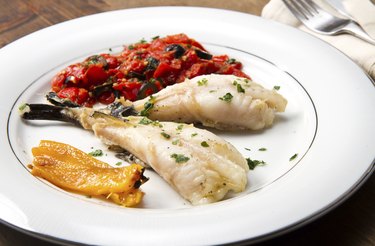
While many home chefs and seafood aficionados are familiar with the best cooking methods for red snapper, cod and orange roughy, fewer are familiar with monkfish, a white-fleshed fish found in northern Atlantic Ocean waters. Monkfish tail -- the only part of the fish that contains enough flesh to use in dishes -- is healthiest when poached, broiled, roasted or grilled. Regardless of cooking method, plan on approximately 8 to 10 minutes of cooking time for every inch of fillet thickness. The fish is done when a thin skewer or knife can pierce the thickest part of the fish with little resistance and the inner portion of the flesh appears opaque.
Poaching
Video of the Day
Poaching is the healthiest way to cook monkfish since it does not require the addition of any fat. Poach monkfish fillets in any liquid, from stock to wine to water to tomato sauce, or a mixture of several different types, seasoned with herbs and spices. Bring the sauce to a boil in a shallow saucepan, place the monkfish in the sauce, use a spoon to cover the fish completely and allow to cook until the fish yields to a thin-bladed knife or skewer. For additional flavor you can saute diced onion in olive oil in the saucepan before adding the liquid, but be aware that this will increase the calorie count -- and total fat content -- of the finished dish. Use a calorie counter to find out the exact nutrition breakdown of monkfish.
Video of the Day
Broiling
Broiling is another low-fat, high-flavor way to cook monkfish, especially if you use a monounsaturated oil like olive oil that is connected to a decrease in overall cholesterol levels and thought to help lower your risk of cardiovascular disease. Place the fillets on a broiling pan sprayed with non-stick spray and brush them lightly with olive oil, then sprinkle with salt, pepper and your choice of spices. Broil the fillets no more than four inches from the preheated heat source until the tops are well-browned, usually about nine minutes per inch of thickness. To make certain that the fish browns evenly, turn the broiler pan every two minutes.
Roasting
Like broiling, roasting is another health-conscious way of preparing monkfish as long as you use monounsaturated or polyunsaturated oils in the cooking process -- olive, peanut, canola, safflower or corn oil are best. Heat the oven to 425 degrees F, lightly oil a baking dish, place the fillets in the dish, drizzle them with oil, sprinkle with salt, pepper and spices and roast for about 10 minutes, or as long as 15 minutes, depending on the thickness of the fillet. To kick it up a notch, try roasting potatoes in the baking dish for 30 to 40 minutes, then placing the monkfish on top of the potatoes and cooking for 10 more minutes.
Grilling
Monkfish is one of the few fish sturdy enough to hold its own on the grill and that's fortunate since grilling is another great choice for low-fat cooking. Choose fillets with their skin intact and coat them with olive oil, seasonings like salt and pepper, and rub with garlic. Heat the grill -- both charcoal and gas grills are fine -- until it is extremely hot, then place the monkfish, skin side up on it. Cook the fish on this side for about five minutes, but use a metal grill spatula to gently loosen the fillet every few minutes to prevent sticking. Grill the fish five minutes on the other side and serve.
Sauteing
While sauteing isn't the heart-healthiest option for cooking monkfish, using a monounsaturated or polyunsaturated oil to saute the fillets instead of butter will keep the saturated fat and cholesterol levels down. For crisp pan-sauteed monkfish fillets, sprinkle the fish with salt an hour before cooking to draw out excess moisture. Heat vegetable or olive oil in a non-stick skillet, wipe the fillets off with paper towels, sprinkle with more salt and freshly ground pepper and dredge the fish in plain flour. Cook the monkfish on high heat, about five minutes per side. If you'd prefer extra-crispy fillets, you can dip the fish in two beaten eggs after dredging in the flour, then coat the fillets with flour one more time before putting it in the skillet, but this step will increase the fish's fat and cholesterol content.